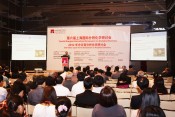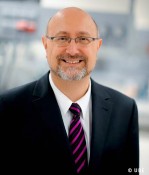|
The analytica China Conference offers solution approaches for contamination of all kinds
The analytica China Conference offers solution approaches for contamination of all kindsScience we needThe People's Republic of China faces a number of challenges such as in the production and packaging of food, the quality control of drugs, air pollution in large cities, and diseases of modern society such as diabetes mellitus. These and other topics will be the focus of this year's analytica China Conference, the title of which is "Analytical chemistry – Science we need". The conference takes place in Shanghai at the same time as analytica China, i.e. from September 24 – 26, 2014. At the analytica China Conference, scientists from Australia, China, Germany, Japan, Poland, South Korea, Switzerland and the United States will give lectures on various fields in analytical chemistry. Besides a plenary lecture with a panel of prominent speakers representing various disciplines, there will also be five additional lecture sessions. They cover topics such as drugs and traditional Chinese medicine, food safety, proteomics and metabolomics, separation techniques and mass spectrometry, environmental analysis and bioanalysis. The program of events will also be rounded out by four several-hour seminars on topics such as quality control, gas chromatography, multidimensional liquid chromatography and HPLC column selection. Science we need While visitors who walk through the exhibition halls get a look at state-of-the-art technology in the sectors for analysis, laboratory technology and biology, those who attend the analytica China Conference have a chance to discover the latest findings in analytical chemistry in two plenary sessions. Examples include the use of ambient ionization methods (e.g. SESI) for breath analysis by Prof. Renato Zenobi (ETH Zurich) or the mechanisms of photoionization in atmospheric pressure mass spectrometry by Prof. Thorsten Benter (University of Wuppertal). Prof. Benter will also report on the latest developments in the field of photoionization and chemical ionization in capillaries. Based on these findings, Prof. Oliver Schmitz will introduce a new photo-ionization source for coupling gas chromatography with an atmospheric pressure orbitrap mass spectro meter in a session on Separation Techniques and Mass Spectrometry. This new type of ion source, which was developed by the Prof. Benter Working Group and the company iGenTraX, stands out because of its outstanding sensitivity. For example, the detection limit for toluene is 100 attograms on column. Many other substances can be reliably quantified in the range of 10 to 20 femtograms on column. This ionization method is only limited by the fact that the components must be amenable to GC analysis (vaporizable without decomposing) and the ionization potential must be below 10 or 10.6 electron volts because the APPI lamp does not emit VUV light at wavelengths of 123.9 and 116.5 nanometers. In the same session, Jack Syage, who developed atmospheric pressure photoionization (APPI) independently of Andries Bruins, will compare electrospray ionization (ESI) using APPI—in each case coupled with HPLC—with regard to ion suppression for drug samples in urine. New types of ionization methods will also be the focus of a series of lectures on food safety. For example, Prof. Heiko Hayen (Westfälische Wilhelms-Universität Münster) will give a presentation on dielectric barrier discharge microplasma ionization, which he helped to develop, for analyzing pesticides in food. Besides these more equipment-oriented presentations, there will also be lectures that deal intensely with theoretical issues and questions that are motivated by applications. For example, visitors attending the conference can find out more about traditional Chinese medicine and the ingredients in Chinese medicinal plants. There will also be several lectures that deal with the latest developments in sample preparation (sample-taking and preconcentration). The extent to which sample preparation influences subsequent metabolome analysis will also be examined. In many cases, complex samples such as those used in environmental or metabolome analysis are processed using two-dimensional gas chromatography (GCxGC). This analysis method will be introduced in two lectures including one from one of the pioneers of GCxGC, Prof. Philip Marriott (Monash University, Australia).
analytica China Conference: gathering of analytical science
Besides chromatography and mass spectrometry methods, other new types of techniques will also be discussed. For example, Prof. Kazuhiko Fujiwara from Akita University in Japan will explain the potential of a new plasma resonance sensor chip based on gold nanoparticles in a series of lectures on environmental analysis and bioanalysis. In the same lecture series, Prof. Albert Sickmann (ISAS) will report on the varying degrees of hydrolysis efficiency of various trypsin qualities in proteomics. A total of 63 English lectures are on the agenda for the analytica China Conference, which is being organized by Messe München International and the Chinese Chemical Society (CCS). The analytica China Conference is also represented by its Chairmen, Prof. Erkang Wang (Changchun Institute of Applied Chemistry, Chinese Academy of Science), Prof. Oliver J. Schmitz (University of Duisburg-Essen), and the Executive Chair, Prof. Jin-Ming Lin (Tsinghua University, Peking).
Prof Dr. Oliver J. Schmitz // Applied Analytical Chemistry // Faculty of Chemistry // University Duisburg-Essen, Germany // Chair analytica China Conference
Additional information is available online at www.analyt Picture: © Fotolia.com | kantver |
L&M int. 3 / 2014
Free download here: download here Read more articles online |









